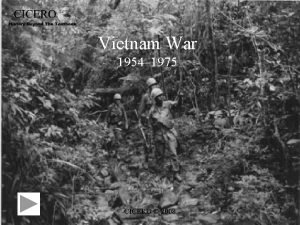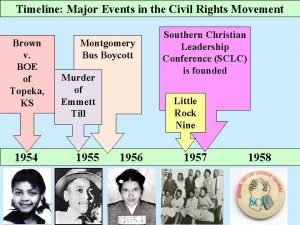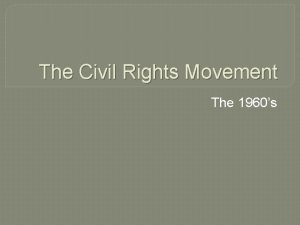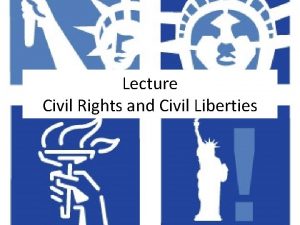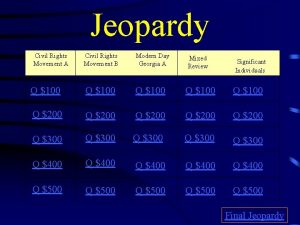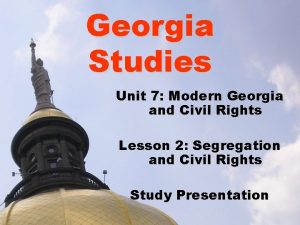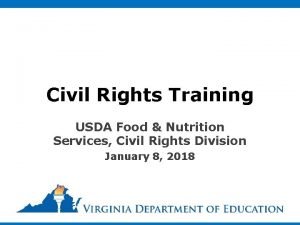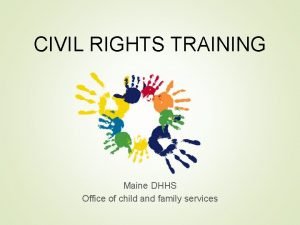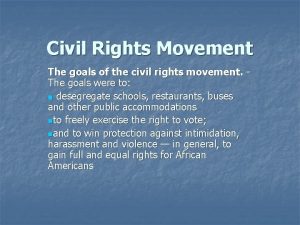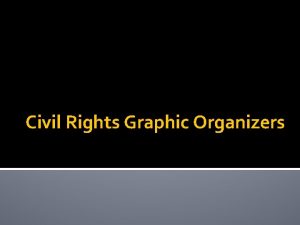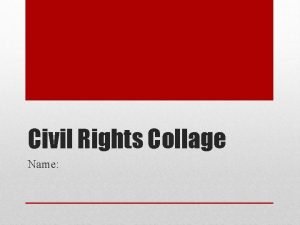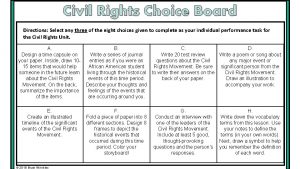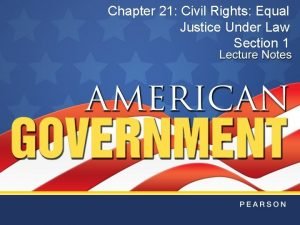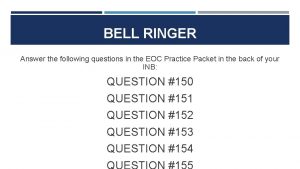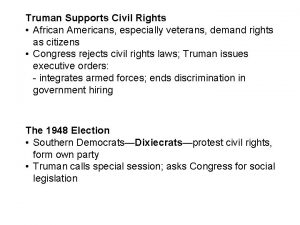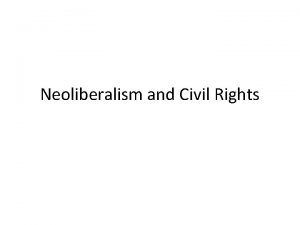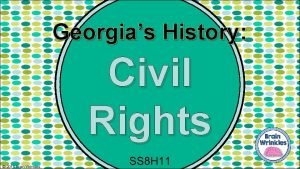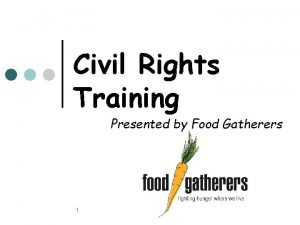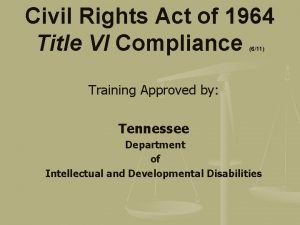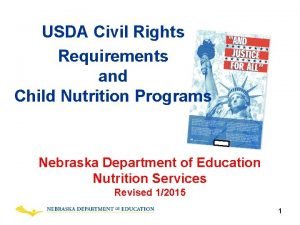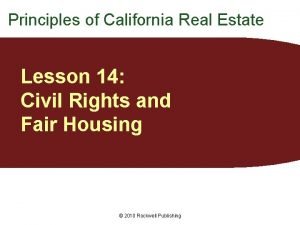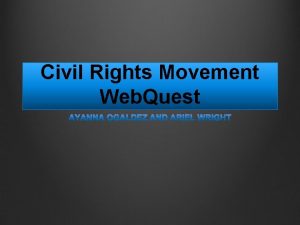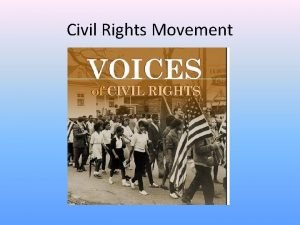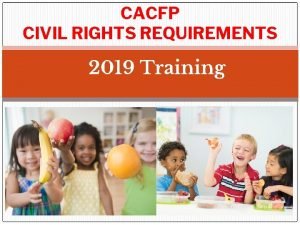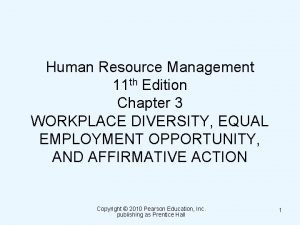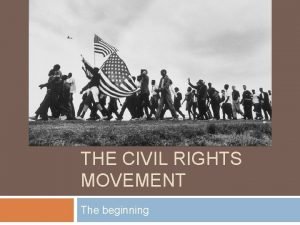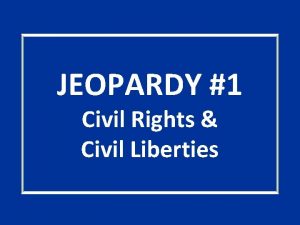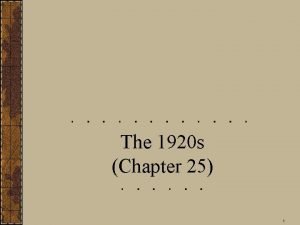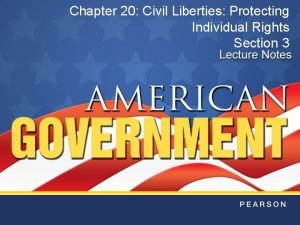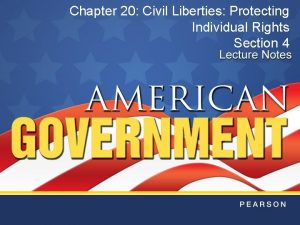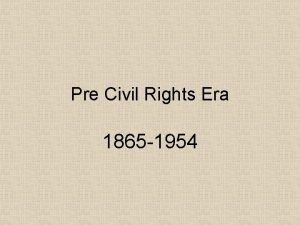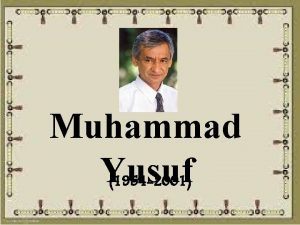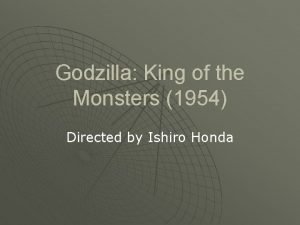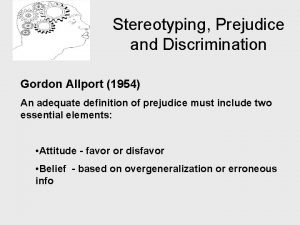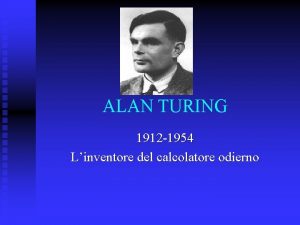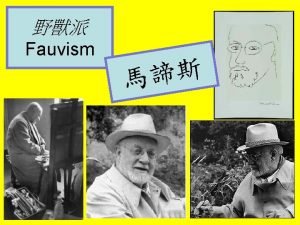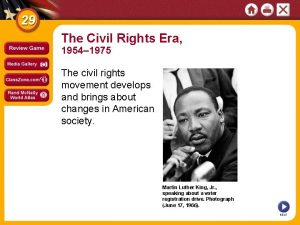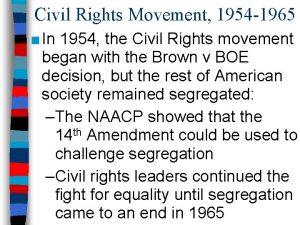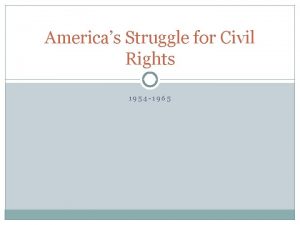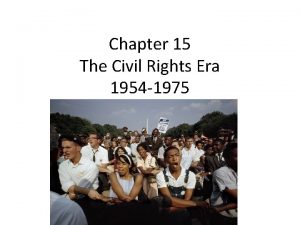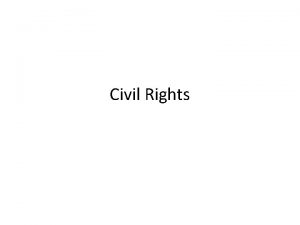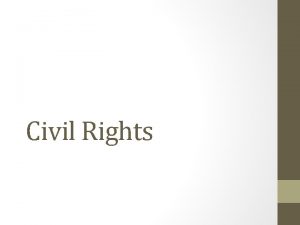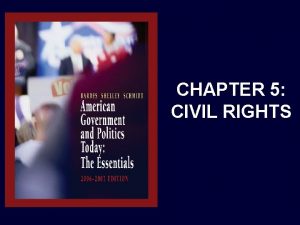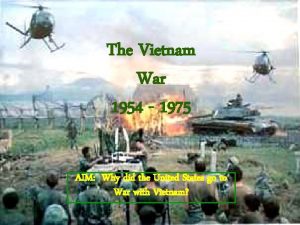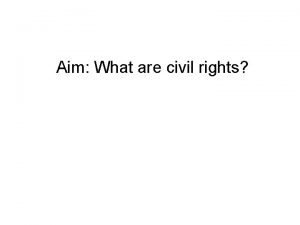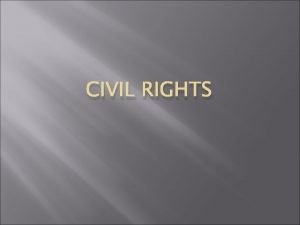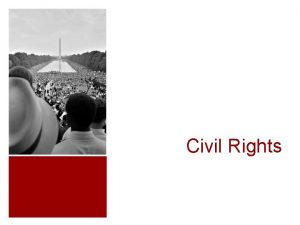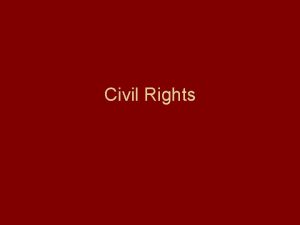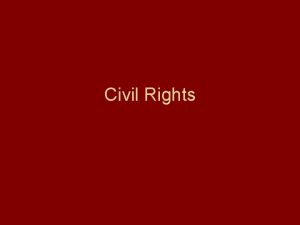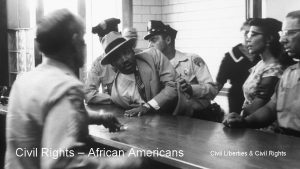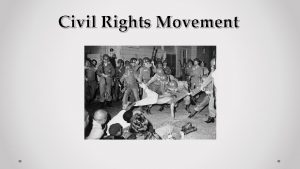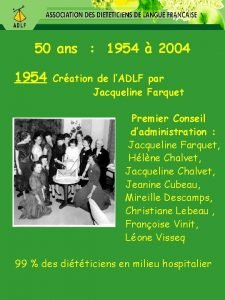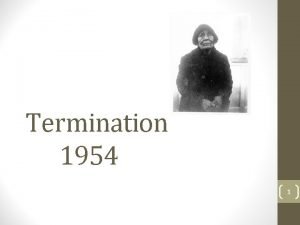New Triangle Civil Rights 1954 1975 AIM Discuss






























































- Slides: 62

New Triangle: Civil Rights 1954 - 1975

AIM Discuss ways in which African Americans have been denied their civil rights Discuss methods that an individual, group or government have used since the 1950 to deal with the inequality faced by African Americans.

Civil Rights n. Civil Rights: –Rights to all people to equal treatment. –Goals: political rights, better job opportunities, and an end to segregation

Patterns of Discrimination n Discrimination existed Discrimination is the act of being throughout America in prejudice against Schools, restaurants, a person because and other public places of race, religion, or gender The struggle to overcome discrimination became known as the Civil Rights Movement n

Early Amendments n 13 th – Abolished slavery n 14 th – Civil Rights/Equal protection under the law n 15 th – Suffrage (Voting Rights) for all men

Discrimination – In the north, African Americans could not get good jobs – In the south, Jim Crow laws enforced strict separation or Segregation of the races

Plessey v. Ferguson Jim Crow Laws n 1896 “Separate but Equal” was constitutional

Opposing Segregation - 1947 n Early successes Jackie Robinson became the first African American to play major league baseball Received many death threats against

Integration of Soldiers - 1948 – President Truman ordered the integration (mixing of ethnic groups) in the armed forces

Linda Brown Imagine you are a seven year old and have to walk one mile to a bus stop by walking through a railroad switching station and then waiting for a school bus to go to a "black elementary school" or a school where only African American children went. This is what happened to Linda Brown, an African American third grader from Topeka, Kansas, even though there was a "white elementary school" only seven blocks away. A "white elementary school" was a school where only white students were able to attend. n For every $150. 00 spent on white children at the "white schools" only $50. 00 was spent on African American children at the "black schools. " n

Thurgood Marshall The attorney in the Brown case n The NAACP hired lawyers to fight for African American children all around the United States to be able to go to the same schools as white children. n Later became the first African American on the US Supreme Court

NAACP National Association for the Advancement of Colored People *Backed up the Brown case

Brown v. Board of Education of Topeka 1954 n Chief Justice Earl Warren: “We conclude that in the field of public education the doctrine of “separate but equal” has no n “Separate but Equal “ place. Separate is un is constitutional in educational facilities education are inherently unequal. ”

Brown v Board of Education n After a 3 year struggle, Nettie Hunt explains to her daughter that segregation in public schools is illegal

1955 – Rosa parks and the Montgomery Bus Boycott Rosa Parks was ordered to give up her seat and move to the back of the bus – Parks refused and was arrested and this lead to the: Montgomery Bus Boycott

Martin Luther King Jr n 26 year old baptist There comes a time when people get tired. We are here this evening to say to those who have mistreated us so long that we are tired – tired of being segregated and humiliated; tired of being kicked about by the brutal feet of oppression. “

Montgomery Bus Boycotts – The NAACP organized a boycott of the bus service – Boycotters, including some whites, organized car pools, rode bikes, or walked to their jobs and schools. – After 13 months, the Supreme Court ruled that segregation on the buses was unconstitutional – The violent reaction of whites to the nonviolent boycott gained the attention of the national media.

Emmett Till • Fourteen-year-old Emmett Till was visiting relatives in Money, Mississippi on August 24, 1955 when he reportedly flirted with a white cashier at a grocery store. • Four days later, two white men kidnapped Till, beat him, and shot him in the head. • The men were tried for murder, but an all-white, male jury acquitted them. • Till's murder and open casket funeral galvanized the emerging civil rights movement.


Organizations Formed n. SCLC n. Southern n. Christian n. Leadership n. Confernec

Little Rock 9 - 1957 n n n September 23, 1957 After Brown v. Board of Education 9 African American students attended Little Rock Central High School in Arkansas. 8 out of the 9 students received phone calls saying someone would drive them to the high school for safety. Elizabeth Eckford had no phone An angry mob was waiting for her at the school and the guard would not let her in the school

Federal Government and Civil Rights/1950’s n n They faced physical and verbal assaults from white students, as well as death threats against themselves and their families The governor of Arkansas used the National Guard to keep African American students from integrating into schools for 3 weeks The governor was defying federal law President Eisenhower sent federal troops to Arkansas to protect black students

The Problem We All Live With Norman Rockwell

Sit-ins Protest in which people sit in one place and refuse to move until their demands are met. n On February 1, 1960, a group of black college students from North Carolina A&T University refused to leave a Woolworth's lunch counter in Greensboro, North Carolina where they had been denied service. n This sparked a wave of other sit-ins in college towns across the South. n Ezell A. Blair, Jr. (now Jibreel Khazan), Franklin E. Mc. Cain, Joseph A. Mc. Neil, and David L. Richmond leave the Woolworth store after the first sit-in on February 1, 1960.

Organizations Formed 1960 SNCC Student Nonviolent Coordinating Committee n The Student Nonviolent Coordinating Committee, or SNCC (pronounced "snick"), was created on the campus of Shaw University in Raleigh two months after the Woolworth sit-in to coordinate sit-ins, support their leaders, and publicize their activities. Over the next few years, SNCC broadened its influence, organizing so-called "Freedom Rides" through the South in 1961 and the historic March on Washington in 1963 They also joined the NAACP in pushing for the passage of the Civil Rights Act of 1964. As its members faced increased violence, SNCC became more militant, and by the late 1960 s it was advocating the "Black Power" philosophy of Stokely Carmichael

President Kennedy 1960 Martin Luther King Jr was arrested n Kennedy’s brother arranged for his release n This led to a large amount of African Americans supporting Kennedy in the election n

Organization - CORE Congress Of Racial Equality They planned freedom rides to desegregate racial segregated interstate buses n Although early CORE membership was chiefly northern, and mostly white, the group took an active role in the Montgomery bus boycott, in lunch counter sit-ins, and in the Freedom Rides in Alabama, and eventually became a largely African-American organization.

Method - Freedom Riders n Protest against segregation on interstate busing in the South n Members of the Washington Freedom Riders Committee, traveling to Washington, D. C. Freedom riders hang signs out of bus windows, New York, 1961.

Freedom Riders * symbolizes violence Occured

A bombed Greyhound Bus Anniston Alabama May 15 th, 1961 In May 1961, CORE sent seven African Americans and six whites on a "freedom ride" on two buses from Washington, D. C. On the 11 th day of the ride, two buses left Atlanta one hour apart. Freedom Riders were on both buses, along with regular passengers. When the first bus crossed the Alabama state line, it was soon surrounded by an angry mob organized by the Ku Klux Klan. In the small town of Anniston, Alabama, approximately 200 men set out to teach the Freedom Riders a lesson. Using metal pipes, clubs and chains, the crowd attacked the bus, smashing windows and denting the sides. After 15 terrifying minutes, the driver was able to pull away, but he quickly realized someone had slashed the tires. Panicked, the driver went for help, abandoning the bus and its passengers. Then, something crashed through a window which set the bus ablaze. With their lungs filled with smoke, Freedom Riders and their fellow passengers spilled out onto the grass—and into the hands of the angry mob.

James Zwerg n A young white man, got off the bus and was greeted with chants of by an angry mob and was beaten to the ground and never attempted to defend himself, even as his face was stomped into the ground.

Ole Miss – University of Mississippi 1962 By the end of the 1950 s, African Americans had begun to be admitted in small numbers to white colleges and universities in the South without too much incident. In 1962, however, a crisis erupted when the state-funded University of Mississippi (known as "Ole Miss") admitted a black man, James Meredith. After nine years in the Air Force, Meredith had studied at the all-black Jackson State College and applied repeatedly to Ole Miss with no success. With the aid of the NAACP, Meredith filed a lawsuit alleging that the university had discriminated against him because of his race. In September 1962, the U. S. Supreme Court ruled in Meredith's favor, but state officials including Governor Ross Barnett vowed to block his admission. When Meredith arrived at Ole Miss under the protection of federal forces including U. S. marshals, a mob of more than 2, 000 people formed on the Oxford, Mississippi campus. Two people were killed and close to 200 injured in the ensuing chaos, which ended only after President Kennedy's administration sent some 31, 000 troops to restore order. Meredith went on to graduate from Ole Miss in 1963, but the struggle to integrate higher education continued. Later that year, Governor George Wallace blocked the enrollment of a black student at the University of Alabama, pledging to "stand in the schoolhouse door. " Though Wallace was eventually forced by the federalized National Guard to integrate the university, he became a prominent symbol of the ongoing resistance to desegregation nearly a decade after Brown v. Board of Education.

King is Arrested 12 April 1963 City officials issued a court injunction to prohibit the civil rights marches that were going on in Birmingham. King lead a peaceful march and was arrested along with his fellow marchers by Police Commissioner Eugene "Bull" Connor for demonstrating without a permit. King was placed in solitary confinement for eight days and wrote the famous "Letter From Birmingham Jail" He used toilet papers and the sides of the newspaper to answer the letter he got from a Priest, the letter was than published as an essay.

“Letters from Birmingham Jail” -Dr. King April 16, 1963 The letter defends the strategy of nonviolent resistance to racism, arguing that people have a moral responsibility to break unjust laws. “I guess it is easy for those who have never felt the stinging darts of segregation to say “wait. . ” but there comes a time when the cup of endurance runs over, and men are no longer willing to be plunged into an abyss (a bottomless pit) of injustice. ”

The March in Birmingham, May 13 th 1963 The march was the culmination of several weeks' previous activities. The march and protest itself lasted several weeks, into most of May. n The Southern Christian Leadership Conference helped organize the march, which consisted mainly of children less than 18 years of age. n One aim of the march was to fill the prisons with students in an effort to embarrass Birmingham city officials. n

Protestors meet violence in Birmingham n n Birmingham Police Chief Eugene "Bull" Connor arrested the student protestors Within days, the police attacked the protestors with Billy clubs, fire hoses and police dogs. The firehouses had enough force to tear peoples clothes off Protestors were met with policemen and dogs.

Publics Reaction The public was horrified n Birmingham’s white leaders agreed to make changes n – News of this on TV incited many Northerners to march. Many who joined the march in Birmingham were beaten or killed. – Martin Luther King was jailed

Ku Klux Klan n n On May 4 th, Chief Connor ordered police and firemen to forcefully instill order in the protestors, but the police and firemen refused. Negotiations were under way for public facilities such as water fountains to be integrated within the next 90 days. When the Ku Klux Klan heard of this impending integration, riots began. The KKK firebombed the Gaston Motel where most protestors were staying, and President Kennedy was forced to call in federal troops to quell the riots and reinstate order.

Violence Against Protestors September 15 th, 1963 These four girls ranging from ages 11 to 14 were killed in a bombing on the sixteenth street Baptist Church in Birmingham n 37 years later a former Ku Klux Klansman was found guilty in a trial for the bombing n

March on Washington August 28 th 1963 Dr. King continued to lead peaceful protests through the 1960 s n Dr. King (reverend) used – Civil disobedience n a non violent protest against an unjust law The March on Washington was held for Jobs and Freedom was held in Washington D. C. More than 250, 000 demonstrators participated in the event Speakers at the event included: – Martin Luther King Jr. of the Southern Christian Leadership Conference (SCLC); – Congressman John Lewis (then a college student and member of the SNCC - Student Nonviolent Coordinating Committee) – Roy Wilkins, executive secretary of the NAACP; and various religious and civic organizations.

“I have a Dream” n I have a dream that my four little children will one day live in a nation where they will not be judged by the color of their skin but by the content of their character. §Dr. King

JFK is shot n Lyndon B Johnson is the New President n

President Johnson pushed for strong civil rights laws

The Civil Rights Act of 1964 n This law banned segregation in public places, such as hotels, restaurants, and theaters. n It created Equal Employment Opportunity Commission to prevent job discrimination n Segregation was finally illegal throughout the United States

Freedom Summer 1964 In 1964, civil rights organizations including the Congress on Racial Equality (CORE) and Student Non-Violent Coordinating Committee (SNCC) organized a voter registration drive, known as the Mississippi Summer Project, or Freedom Summer, aimed at dramatically increasing voter registration in Mississippi. The Freedom Summer, comprised of black Mississippians and more than 1, 000 out-of-state, predominately white volunteers, faced constant abuse and harassment from Mississippi's white population. The Ku Klux Klan, police and even state and local authorities carried out a systematic series of violent attacks; including arson, beatings, false arrest and the murder of at least three civil rights activists.

“Mississippi Burning” §The summer had barely begun, however, when three volunteers–Michael Schwerner and Andrew Goodman, both white New Yorkers, and James Chaney, a black Mississippian– disappeared on their way back from investigating the burning of an African-American church by the Ku Klux Klan. §After a massive FBI investigation (code-named "Mississippi Burning") their bodies were discovered on August 4 buried in an earthen dam near Philadelphia, in Neshoba County, Mississippi. §The FBI arrested 18 men in October 1964, but state prosecutors refused to try the case, Although the culprits in the case–white supremacists who included the county's deputy sheriff– were soon identified, the state made no arrests claiming lack of evidence. § The federal government then stepped in, and the FBI arrested 18 in connection with the killings and after a three-year-long legal battle, the men finally went on trial in Jackson, Mississippi. § In October 1967, an all-white jury found seven of the defendants guilty and acquitted the other nine. Though the verdict was hailed as a major civil rights victory–it was the first time anyone in Mississippi had been convicted for a crime against a civil rights worker–the judge in the case gave out relatively light sentences, and none of the convicted men served more than six years behind bars.

Justice January 7, 2005 On Jan. 7, 2005, four decades after the crime, Edgar Ray Killen, then 80, was charged with three counts of murder. He was accused of orchestrating the killings and assembling the mob that killed the three men. On June 21—the 41 st anniversary of the murders—Killen was convicted on three counts of manslaughter, a lesser charge. He received the maximum sentence, 60 years in prison. The grand jury declined to call for the arrest of the seven other living members of the original group of 18 suspects arrested in 1967.

Selma to Montgomery March – 1965 “Bloody Sunday” • Martin Luther King Jr. 's Southern Christian Leadership Conference (SCLC) made Selma, Alabama, the focus of its efforts to register black voters in the South. SCLC colleague Hosea Williams and SNCC leader John Lewis led the march • That March, protesters attempting to march from Selma to the state capital of Montgomery were met with violent resistance by state and local authorities. • On "Bloody Sunday, " March 7, 1965, some 600 civil rights marchers headed east out of Selma on U. S. Route 80. They got only as far as the Edmund Pettus Bridge six blocks away, where state troopers and local lawmen commanded by Clark and Major John Cloud who ordered the marchers to disperse. Cheered on by white onlookers, the troopers attacked the crowd with clubs and tear gas. Mounted police chased retreating marchers and continued to beat them.

Selma to Montgomery March – 1965 Two days later on March 9, Martin Luther King, Jr. , led a "symbolic" march to the bridge. Then civil rights leaders sought court protection for a third, full-scale march from Selma to the state capitol in Montgomery. Federal District Court Judge Frank M Johnson Jr weighed the right of mobility against the right to march and ruled in favor of the demonstrators. "The law is clear that the right to petition one's government for the redress of grievances may be exercised in large groups. . . , " said Judge Johnson, "and these rights may be exercised by marching, even along public highways. " On Sunday, March 21, about 3, 200 marchers set out for Montgomery, walking 12 miles a day and sleeping in fields. By the time they reached the capitol on Thursday, March 25, they were 25, 000 strong. Less than five months after the last of the three marches, President Lyndon Johnson signed the Voting Rights Act of 1965 --the best possible redress of grievances. As the world watched, the protesters (under the protection of federalized National Guard troops) finally achieved their goal, walking around the clock for three days to reach Montgomery. (54 miles) The historic march, and King's participation in it, greatly helped raise awareness of the difficulty faced by black voters in the South, and the need for a Voting Rights Act, passed later that year.

Civil Rights Laws – The Voting Rights Act of 1965 ended literacy tests and allowed thousands of African Americans to vote for the first time

Black Panthers n n The Black Panthers were formed in California in 1966 and they played a short but important part in the Civil right s movement. The Black Panthers believed that the non-violent campaign of Martin Luther King had failed any promised changes to their lifestyle via the 'traditional' civil rights movement, would take too long to be implemented or simply not introduced. The language of the Black Panthers was violent as was their public stance. The two founders of the Black Panther Party were Huey Percy Newton and Bobby Seale. They preached for a "revolutionary war" but though they considered themselves an African-American party, they were willing to speak out for all those who were oppressed from whatever minority group. They were willing to use violence to get what they wanted. The Black Panther Party (BPP) had four desires : equality in education, housing, employment and civil rights

Black Panthers 10 Point Plan to get its desired goals. The ten points of the party platform were: 1) "Freedom; the power to determine the destiny of the Black and oppressed communities. 2) Full Employment; give every person employment or guaranteed income. 3) End to robbery of Black communities; the overdue debt of forty acres and two mules as promised to ex-slaves during the reconstruction period following the emancipation of slavery. 4) Decent housing fit for the shelter of human beings; the land should be made into cooperatives so that the people can build. 5) Education for the people; that teaches the true history of Blacks and their role in present day society. 6) Free health care; health facilities which will develop preventive medical programs. 7) End to police brutality and murder of Black people and other people of color and oppressed people. 8) End to all wars of aggression; the various conflicts which exist stem directly from the United States ruling circle. 9) Freedom for all political prisoners; trials by juries that represent our peers. 10) Land, bread, housing, education, clothing, justice, peace and community control of modern industry. "

Malcolm X – Malcolm Little A black leader who, as a key spokesman for the Nation of Islam, epitomized the "Black Power" philosophy because By the early 1960 s, he had grown frustrated with the non-violent, integrated struggle for civil rights n Malcolm X was a prominent figure during the Civil Rights era who offering an alternative view to the mainstream Civil Rights movement n Malcolm X advocated for both the establishment of a separate black community (rather than integration) and the use of violence in self defense (rather than non-violence). n Although he left the Nation of Islam. in February 1965, he was killed by members of the Nation of Islam; n

King Assassinated During the years of riots, King remained committed to nonviolence n In Memphis, Tennessee while supporting black sanitation workers, n King was killed by an assassinated by (James Earl Ray) n

Fair Housing Act The Fair Housing Act of 1968, meant as a follow-up to the Civil Rights Act of 1964, marked the last great legislative achievement of the civil rights era. Originally intended to extend federal protection to civil rights workers, it was later expanded to address racial discrimination in the sale, rental or financing of housing units. On the day of the Senate vote, however, Martin Luther King Jr. was assassinated in Memphis. Pressure to pass the bill increased amid the wave of national remorse that followed, and after a strictly limited debate the House passed the Fair Housing Act on April 10. President Johnson signed it into law the following day. Over the next years, however, there was little decrease in housing segregation, and violence arose from black efforts to seek housing in white neighborhoods. From 1950 to 1980, the total black population in America's urban centers increased from 6. 1 million to 15. 3 million; during this same time period, white Americans steadily moved out of the cities into the suburbs, taking with them many of the employment opportunities blacks needed. In this way, the ghetto–an inner city community plagued by high unemployment, crime and other social ills–became an ever more prevalent fact of urban black life.

Higher Education Act 1972 On this day in 1972, President Richard Nixon signs into law the Higher Education Act, which includes the groundbreaking Title IX legislation. Title IX barred discrimination in higher education programs, including funding for sports and other extracurricular activities. As a result, women's participation in team sports, particularly in collegiate athletics, surged with the passage of this act.

Rodney King & LA Riots In March 1991, officers with the California Highway Patrol attempted to pull an African-American man named Rodney King over for speeding on a Los Angeles freeway. King, who was on probation for robbery and had been drinking, led them on a high-speed chase, and by the time the patrolmen caught up to his car, several officers of the Los Angeles Police Department were on the scene. After King allegedly resisted arrest and threatened them, four LAPD officers shot him with a TASER gun and severely beat him. Caught on videotape by an onlooker and broadcast around the world, the beating inspired widespread outrage in the city's African-American community, who had long condemned the racial profiling and abuse its members suffered at the hands of the police force. Many demanded that the unpopular L. A. police chief, Daryl Gates, be fired and that the four officers be brought to justice for their use of excessive force. The King case was eventually tried in the suburb of Simi Valley, and in April 1992 a jury of 11 whites and one Hispanic found the officers not guilty.

LA Riots - 1992 Rage over the verdict sparked four days of riots, beginning in the mostly black South Central neighborhood. By the time the riots subsided, some 55 people were dead, more than 2, 300 injured, and more than 1, 000 buildings had been burned. Authorities later estimated the total damage at around $1 billion. The next year, two of the four LAPD officers involved in the beating were retried and convicted in a federal court for violating King's civil rights; he eventually received $3. 8 million from the city in a settlement.

Affirmative Action n Affirmative action programs were designed to promote minorities and women & call for the hiring or college admittance of women and minorities

Successes Cosby Show Robert L. Johnson founded Black Entertainment Television (BET), OPRAH Colin Powell as secretary of state - first African American to serve as America's top diplomat. Best Actress - Oscars Obama

Discuss ways in which African Americans have been denied their civil rights Slavery (early years) n Denial of voting (15 th amendemnt) – Poll tax. Literacy test, and grandfather clause n Segregation, Jim Crow Laws – Plessy v Ferguson (1896) n Murder – Ku Klux Klan – Lynching – Emmett Till n

Discuss methods that an individual, group or government have used since the 1950 to deal with the inequality faced by African Americans. Methods: Speeches, Marches, Protests, Laws Government: 13 th, 14 th, 15 th Amendments Ike sending in National Guard to protect Little Rock 9 Students Eisenhower sending in military during freedom rides Johnson passing the Civil Rights Act 1964 Voting Rights Act 1965 Individuals: Early – Harriet Tubman, Fredrick Douglas Rosa Parks, ED Nixon – Montgomery Bus Boycott 1955 Thurgood Marshall- Lawyer in Brown v Board of Education, Linda Brown MLK –Civil Disobedience, Letters from Birmingham, March on Washington, I have a Dream Speech Malcolm X Marcus Garvey Groups: SCLS, NAACP, CORE, SNCC, Black Panthers
 Vietnam 1954
Vietnam 1954 Civil rights webquest
Civil rights webquest Amateurs talk tactics professionals talk logistics
Amateurs talk tactics professionals talk logistics Civil rights timeline of events
Civil rights timeline of events Civil rights sitins
Civil rights sitins Rosa parks mother
Rosa parks mother La raza apush
La raza apush Right to die
Right to die Civil rights movement jeopardy
Civil rights movement jeopardy Unit 7: modern ga and civil rights
Unit 7: modern ga and civil rights Usda civil rights training
Usda civil rights training Civil rights training child nutrition programs
Civil rights training child nutrition programs Goals of the civil rights movement
Goals of the civil rights movement Civil rights in child nutrition programs
Civil rights in child nutrition programs Civil rights graphic organizer
Civil rights graphic organizer Civil rights collage
Civil rights collage Civil rights choice board
Civil rights choice board Chapter 21 civil rights equal justice under law
Chapter 21 civil rights equal justice under law Chapter 20 civil liberties protecting individual rights
Chapter 20 civil liberties protecting individual rights Civil rights bell ringers
Civil rights bell ringers Truman supports civil rights
Truman supports civil rights Characteristics of civil rights
Characteristics of civil rights Civil rights cloze notes 1
Civil rights cloze notes 1 Brain wrinkles social studies answer key
Brain wrinkles social studies answer key Federally protected classes
Federally protected classes Title vi of the civil rights act of 1964
Title vi of the civil rights act of 1964 Civil rights in child nutrition programs
Civil rights in child nutrition programs Civil rights movement vocabulary
Civil rights movement vocabulary Unruh civil rights act real estate
Unruh civil rights act real estate Civil rights movement webquest
Civil rights movement webquest Civil rights movment
Civil rights movment Cacfp civil rights
Cacfp civil rights Title vii of the civil rights act
Title vii of the civil rights act Title vii of the civil rights act
Title vii of the civil rights act The civil rights movement
The civil rights movement Civil rights jeopardy
Civil rights jeopardy Civil rights movement essential questions
Civil rights movement essential questions Chapter 14 postwar prosperity and civil rights
Chapter 14 postwar prosperity and civil rights What did the civil rights act of 1875 do
What did the civil rights act of 1875 do Chapter 20 civil liberties protecting individual rights
Chapter 20 civil liberties protecting individual rights Chapter 20 civil liberties protecting individual rights
Chapter 20 civil liberties protecting individual rights 15 th ammendment
15 th ammendment Magnétoscope 1954
Magnétoscope 1954 Muhammad yusuf maylida kimgadir yoqsa yoqmasa
Muhammad yusuf maylida kimgadir yoqsa yoqmasa Godzilla king of the monsters 1954
Godzilla king of the monsters 1954 Fortran 1954
Fortran 1954 Fortran
Fortran 1970-1954
1970-1954 Ruby bridges how old is she
Ruby bridges how old is she Allport 1954
Allport 1954 Frida kahlo 1907 a 1954
Frida kahlo 1907 a 1954 Ron hubbard 1954
Ron hubbard 1954 1949 cadillac series 62 4 door
1949 cadillac series 62 4 door Incident method
Incident method 1954
1954 Hurricane hazel track
Hurricane hazel track Point o woods beach
Point o woods beach Henri matisse portrait of lydia
Henri matisse portrait of lydia Başhemşire nasıl olunur
Başhemşire nasıl olunur Positive rights vs negative rights
Positive rights vs negative rights Littoral real estate
Littoral real estate Duties towards self
Duties towards self Legal rights vs moral rights
Legal rights vs moral rights
